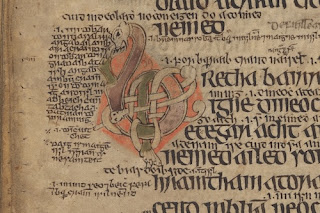The Derrynaflan Chalice was discovered rather recently, in 1980, as part of a hoard of five liturgical vessels found in County Tipperary on the site of an early Irish abbey. Unlike the accidental discovery at Ardagh when the boys were digging for potatoes, the Derrynaflan discoverers were exploring the abbey site with a metal detector. Similar to the Ardagh situation, ownership of the find was disputed. The discoverers, father and son, were given permission to wander the land, but the ruins were protected under the National Monuments Act of 1930, and digging up anything on the site was not permitted. They kept their find secret for weeks before revealing it and trying to claim ownership and trying to sell it for £5,000,000. They were unsuccessful, and the find went to the National Museum of Ireland.
The Derrynaflan Hoard is of the same vintage (8th - 9th centuries) as the Ardagh Hoard, displaying the same intricate detail. It included a silver paten, a hoop that may have been intended to support the paten, and a strainer. A bronze basin was inverted on top of the four items, suggesting it was deliberately buried that way to keep the items preserved.
The Tara Brooch was a little earlier (late-7th - early-8th centuries). It is so finely detailed that a magnifying glass is needed to appreciate parts of the design. It was found c.1850 on a beach on the east coast of Ireland, 25 miles from Tara, and despite its name has no real connection to the Hill of Tara. It was given that name by a Dublin jeweler named George Waterhouse who wanted to make and sell copies during the Celtic Revival and thought the name would add mystique and grandeur and create more customers.Although it is impossible to know the origin of these items, there are occasional random hints about them in history. As I mentioned in the post on St. Brigid, Gerald of Wales makes a reference to a book at Kildare that might just be the Book of Kells. The Book of Leinster (12th century) mentions an elaborate brooch buried after a defeat. Historians wonder if the burial of the Tara Brooch was deliberate to commemorate a tragedy, and not an accidental loss.
What was the Celtic Revival? Although it was well past the Middle Ages, let's talk about it tomorrow.




















